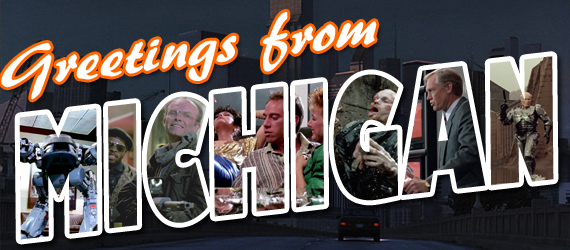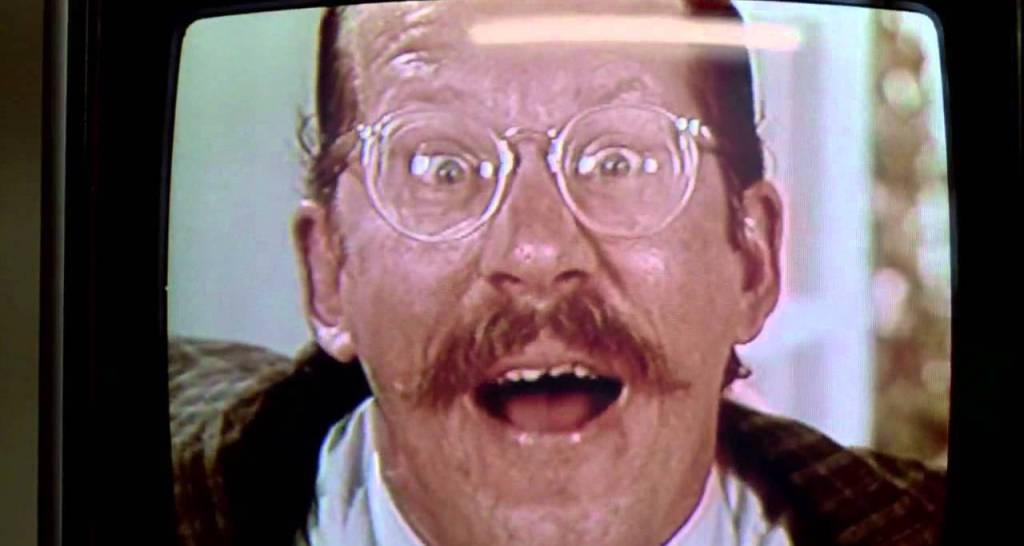
I’ve always wanted to travel across America. I’ve been a few times, to the major tourist attractions – Disneyworld in Florida, Vegas in Nevada, Cheers in Boston – but there’s so many places I’ve never seen in person, and most likely never will. Fortunately, there’s a solution, and it’s my own personal remedy to all life’s problems: movies. There’s been a movie set literally everywhere. Everywhere! So, this feature sees me cinematically visit a new state every week, through a film that was set there. You can read my journey so far here. Next up: Michigan!
At some point in the future, crime in the United States – specifically Detroit – has become so out of control that the only way to adequately police it is with robots. Sounds cool, right? Unfortunately, the first prototypes – lumbering bipedal tanks called ED-209s – have a slight flaw that sees them killing their targets even after they’ve given themselves up. When OCP – the company charged with defending the city – opts not to use the ED-209s, an alternative solution is devised. Instead of building a robotic policeman from scratch, why not combine a critically wounded officer with replacement limbs to create the ultimate policeman. So when Alex Murphy (Peter Weller) is all but killed on duty, he becomes the perfect test subject for this new directive.
Just to be clear, I’m talking about the 1987 Paul Verhoeven classic film, not the 2014 yawn-fest starring Joel Kinneman and the space where Abbie Cornish’s personality should be. There’s a strong possibility the remake will be brought up during this review, but in the mean-time let’s get on with this film. It’s often remarked that the better science fiction films have something to say about modern life, and that’s very much the case with RoboCop. Along with fake commercials for orbiting peace platforms and nuclear-based board games exposing the more crass side of commercialism, there’s also a deeply grained presence that the city is less interested in the welfare of its inhabitants, and more focussed on the almighty dollar. I’m not saying that economics and finance shouldn’t be pretty high on the priority list, but it becomes somewhat suspect when they start sending police officers into notoriously dangerous areas simply so they’ll be gunned down and become eligible for the new RoboCop directive.
This movie is an absolute classic. This was pretty much the first time I’d seen it in its entirety (I’d caught glimpses here and there before) and I really kind of loved it. Science fiction films in recent years have taken something of a downward spiral into the mundane – think of Oblivion, After Earth and the remakes of both RoboCop and Total Recall. They all have something missing – they simply aren’t memorable. There’s a bland, unexciting, almost boring quality to them (I fell asleep during both Oblivion and Total Recall, and After Earth was only bearable because my phone was to hand). This RoboCop, however, is full to bursting with interesting, fun and, yes at times some silly factors, but they all build to what is an experience that stays with you, and very much for the better.
On paper, and in fact even on screen, not all of these elements adhere to the traditional standards of quality film-making. There’s the jerky, animal-like flailing of the stop-motion ED-209 bested by a flight of stairs, or the henchman of Kurtwood Smith’s Clarence J. Boddicker, one of whom does little more than laugh maniacally, whilst another suffers my favorite henchman death in history when he comes into contact with some toxic waste. Elsewhere, stereotypes are rigidly applied too – the angry black police chief (Robert DoQui), the gum-chewing strong female sidekick (Nancy Allen), the secretly evil corporate manager who doesn’t realise his villainy is supposed to be a surprise (Ronny Cox) – but there’s moments of outside-of-the-box insanity thrown in too, like the short clips on televisions we see of Bixby Snyder (S.D. Nemeth), a Benny-Hill-meets-Timmy-Mallett TV personality who screams “I’d buy that for a dollar!” whilst groping scantily clad women. It adds nothing to the plot, makes very little sense other than depicting what passes for entertainment in the future in a similar fashion aped some years later by Idiocracy, but it’s a fun little throwaway sequence that adds to the cult appeal of the movie as a whole.
The reasoning behind all this extra material could be due to the lead. Before Star Trek Into Darkness, Peter Weller was just the RoboCop guy to me, because it’s safe to say he isn’t a tremendous actor. He’s not bad, but there might be a reason for why he was selected to portray a character to whom emotions do not come naturally. This leads to a main character who is sympathetic but not in the least bit charismatic, so if we didn’t have quite so many entertaining villains to deal with the film would be a much more boring viewing experience. The introduction of RoboCop himself, however, is a masterclass in slowly increasing the amount you see of him. First he walks past a TV monitor, with his image appearing a little distorted on the screen. Then we catch a glimpse through a frosted window, then from behind, through a mesh fence and from below, before we finally get the big reveal. This kind of film-making doesn’t really mean anything any more, because the Internet becomes inundated with set pictures, promotional imagery and spoiler-laden posters long before the film – or even the trailer – has been released, so here it’s a real treat.
This is a great film. It’s a little gorier than I’d like – the surgery scene after Murphy’s attack is particularly gruesome, regardless of how fake it looks – but there’s far more here to like than to not. Yes, it’s campy, yes, the henchmen are clearly grabbing handrails and throwing themselves over instead of falling backwards after being shot, but still, it’s fun, and I’m very much looking forward to watching it again.



